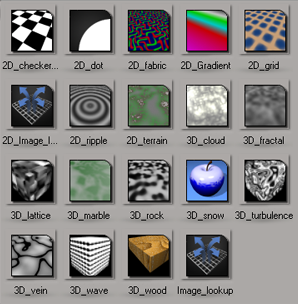A shader is a miniature computer program that controls the behavior of the rendering software during, or immediately after (in the case of output shaders), the rendering process. Some shaders are invoked by mental ray (the default renderer) to compute the color values of pixels. Other shaders can displace or create geometry on the fly. There are many different types of shaders: surface, environment, volume, light, lens, texture, and so on.

Thumbnails of shader presets available from the shader library
To create shader effects, you have to connect shaders to one another. The recommended tool for working with shaders is The Render Tree, but there are other methods such as the Get  Material menu, the Get
Material menu, the Get  Shaders menu, or simply mapping shaders together via their connection icons.
Shaders menu, or simply mapping shaders together via their connection icons.
However, under the hood, the latter methods always build a render tree of inter-connected shaders that ultimately define an object's material appearance. For more information about materials and their relationship to shaders, see About Materials.